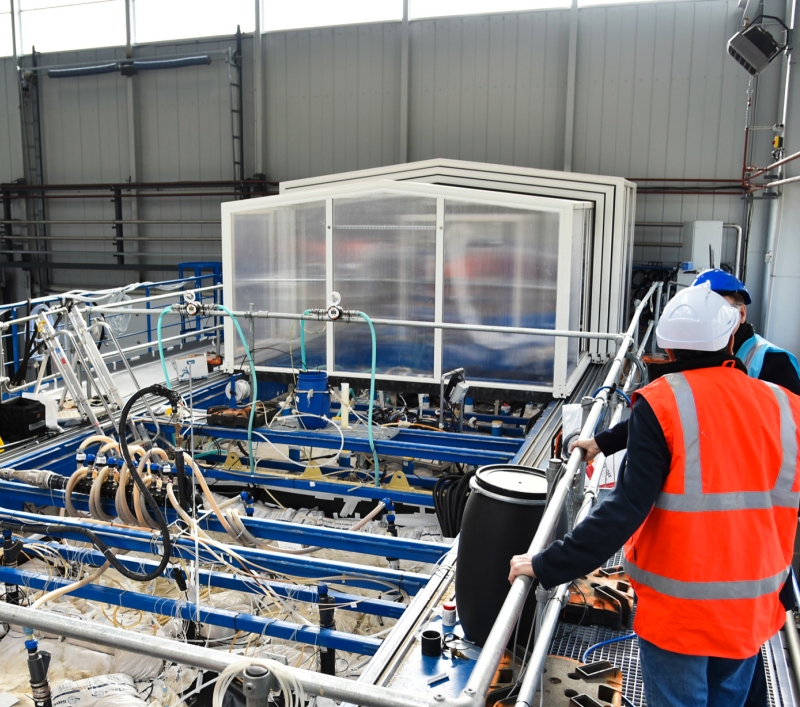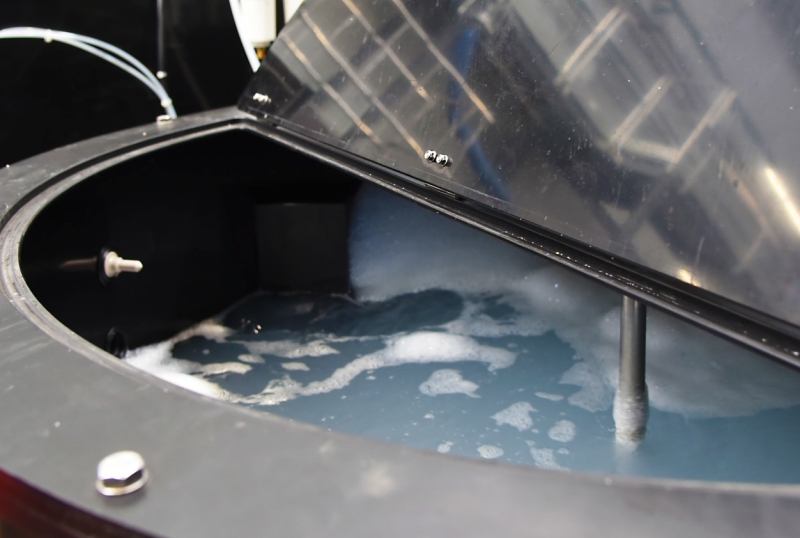BRGM installed an 80 m3 pilot unit on the PRIME platform to characterise the infiltration into the subsoil of the PFAS contained in fire-fighting foams. © BRGM
Risks linked to the ground and subsurface
Outstanding result / Towards the treatment of forever pollutants
PFAS are valued for their many properties – non-stick, waterproof, heat-resistant, etc. – and used in many sectors of industry (such as pharmaceuticals, plant health, cosmetics, aerospace, textiles) and in all sorts of everyday products, from frying pans to clothing, food packaging and some types of fire-fighting foam. However, they are also the most persistent man-made substances known to date, owing to the chemical and physical stability of their carbon-fluorine bonds. Although the use of per- and polyfluoroalkyl substances, or “PFAS”, is increasingly regulated in terms of production, use and monitoring, these synthetic compounds are already present in large quantities in the environment, since they were first manufactured in the 1950s. And we’re talking about several thousand distinct molecules!
A review of international knowledge
At BRGM, no fewer than twenty scientists are working on this subject, which touches on several areas. BRGM is also closely involved in the interministerial action plan on PFAS launched in the spring of 2024, particularly in terms of knowledge. “We drew up an inventory of the various PFAS likely to be present on sites using fire-fighting foams around the world, with the aim of identifying the substances that could be monitored in France and developing the methodology to be implemented,” explains Amélie Cavelan. “We also reviewed the methods and results of international campaigns to determine the background values of PFAS in soils. Finally, we reviewed the practices implemented around the world to find, identify and quantify these molecules in a given environment.” At the same time, the “Info PFAS” online tool launched in summer 2025 will make it possible to view all the public data collected as part of this plan, and even more widely. “These studies all feed into each other and add to our knowledge,” continues Julie Lions. ActiviPoll, the BRGM website listing and qualifying the correlations between economic activities and any associated pollution, has thus been supplemented with information on PFAS.
BRGM is also carrying out multidisciplinary research and development studies on the behaviour of these molecules and their destruction. And progress has been significant. Launched in 2021 and coordinated by BRGM, the European project PROMISCES makes it possible to study the entire PFAS treatment chain on a large scale, using the PRIME experimental platform, dedicated to the remediation of polluted soil and groundwater. “We installed an 80 m3 ‘multi-metre pilot’ to track the infiltration of fire-fighting foam into the ground and the transfer of PFAS into the groundwater, using a battery of monitoring devices,” explains Stefan Colombano. “These data were used to characterise the behaviour of the molecules and to model their distribution in the subsoil.”
BRGM has developed a process using “rheofluidifying” liquids to extract PFAS from contaminated soils. © BRGM
Technical and economic optimisation
The multi-metre pilot is then used to test pollution remediation techniques and assess their efficiency in purification. Two methods are used to destroy PFAS: advanced chemical reduction and oxidation, which uses a solvent to break the carbon-fluorine bonds, and ultrasonic cavitation, which uses ultrasound waves in water to generate micro-bubbles that implode and degrade the molecules. “These techniques perform differently and complement each other in terms of reaction speed, the concentration of PFAS that can be treated and the destruction rate,” explains Maxime Cochennec. “However, they also have their drawbacks, notably in terms of the amount of energy required and the cost of treatment. Current research is therefore seeking to optimise these decontamination methods from a technical and economic standpoint.” The first major step is to extract the PFAS. Using “rheofluidifying” fluids, BRGM has developed an effective process to extract as large a quantity as possible with as little liquid as possible. The second key stage is to reconcentrate the PFAS. “Our next research projects will focus in particular on this operation, which precedes destruction,” says Stefan Colombano.
The results of PROMISCES, completed in April 2025, are already feeding into public policies on PFAS. “As well as providing a decision-support tool online for managers of polluted sites, soils and water, we have drafted policy briefs and recommendations to guide public action and research programming in this area,” says Julie Lions.











